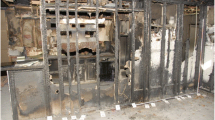Abstract
The science behind the formation of fire patterns and their ensuing use in the forensic analysis of fire scenes has been questioned since their introduction in the 1940s. This paper provides an overview of a prototype method for determining the area of origin based on fire patterns analysis, named the process for origin determination (POD). The POD is a seven step reasoning process for evaluating fire damage, which starts by identifying the value in further analysis of each surface and compartment of a structure and then procedurally evaluates each surface for use within the overall determination. This paper outlines the application of the POD with test subjects and presents an analysis of the outcomes showing its benefits. To facilitate testing the POD, numerical simulations and physical experiments were employed. The numerical simulations were completed through the use of fire dynamics simulator simulating a single compartment measuring 3.66 m × 3.66 m × 2.44 m with a single ventilation opening. The physical experiments were tests conducted specifically for fire patterns where accuracy rates had been previously identified in the literature. Sixty test subjects participated in the evaluation of thirty-two different origin scenarios. A decrease in variability, which indicates an increase in reliability, was noted in 21 of the 32 scenarios (66%) when participants used the POD. Three accuracy measurements were employed, all three of which illustrated an increase in accuracy when participants used the POD. The accuracy was shown to increase between 50% and 94% when participants used the POD.











Similar content being viewed by others
References
Rethoret H (1945) Fire investigations. Recording and Statistical Corp, Ltd., Carleton Place
NFPA 921 (2014) Guide for fire and explosion investigation. National Fire Protection Association, Quincy
Gorbett GE, Meacham BJ, Wood CB, Dembsey NA (2015) Use of damage in fire investigation: a review of fire patterns analysis, research and future direction. Fire Sci Rev 4:1
National Academy of Science (2009) Strenthening forensic science in the United States: a path forward. National Research Council, Washington
Gorbett G (2015) Development and assessment of a decision support framework for enhancing the forensic analysis and interpretation of fire patterns. Dissertation, Worcester Polytechnic Institute
Gorbett GE, Morris S, Meacham BJ, Wood CB (2014) A new method for the characterization of the degree of fire damage to gypsum wallboard for use in fire investigations. J Forensic Sci. doi:10.1111/1556-4029.12616
Mealy C, Gottuk D (2012) A study of calcination of gypsum wallboard. paper presented at the international symposium on fire investigations. Investigations Institute
Mann D, Putaansuu N (2010) Studies of the dehydration/calcination of gypsum wall board. International Association of Arson Investigators 61:38–44
Ngu C (2004) Calcination of gypsum plasterboard under fire exposure. Dissertation, University of Canterbury
Riahi S (2012) Development of tools for smoke residue and deposition analysis. NIJ Grant No. 2007-DN-BX-K236. Department of Justice
Riahi S, Beyler C (2011) Measurement and prediction of smoke depsoition from a fire against a wall. Fire Safety Sci 10:641–654
Riahi S, Beyler C, Hartman J (2013) Wall smoke deposition from a hot smoke layer. Fire Technol 49:395–409. doi:10.1007/s10694-012-0273-x
Taroni F, Aitken C, Garbolino P, Biedermann A (2006) Bayesian networks and probabilistic inference in forensic science. Wiley, West Sussex
Babrauskas, V. (1980). Estimating room flashover potential. Fire Technol 16(2):95–103
McCaffrey B, Quintiere J, Harkleroad M (1981) Estimating room temperature and likelihood of flashover using fire test data correlation. Fire Technol 17(2):98–119. doi:10.1007/BF02993495
Thomas P (1981) Testing products and materials for their contribution to flashover in rooms. Fire Mater 5(3):103–111
Carman S (2008) Burn pattern development in post-flashover fires. International symposium on fire investigation science and technology
Oullette J (2008) ATF FRL fire test report 3589, 3593, 3595. ATF, Ammendale
Tinsley A, Gorbett G (2012) Fire investigation origin determination survey. Fire Arson Invest J IAAI 63(4):24–40
Qualtrics, Version 40829, Copyright © 2013, Qualtrics Labs, Inc., Provo
Smith S (2013) 4 ways to ensure valid responses for your online survey [Web Log Comment]. Retrieved from http://www.qualtrics.com/blog/online-survey-valid-responses/
Giannelli P (1980) The admissibility of novel scientific evidence: Frye v. United States. A half-century later. Columbia Law Rev 80:1197–1250.
Upton G (1992) Fisher’s exact test. J Roy Stat Soc 155(3):395–402
Conover W, Iman R (1981) Rank transformations as a bridge between parametric and nonparametric statistics. Am Stat 35(3):124–129
McGrattan K, McDermott R, Weinschenk C, Overholt K, Hostikka S, Floyd J (2013) Fire dynamics simulator technical reference guide volume 3: validation. NIST Special Publication 1018, 6th edition
Author information
Authors and Affiliations
Corresponding author
Additional information
An erratum to this article is available at http://dx.doi.org/10.1007/s10694-016-0626-y.
Rights and permissions
About this article
Cite this article
Gorbett, G.E., Meacham, B.J., Wood, C.B. et al. Structure and Evaluation of the Process for Origin Determination in Compartment Fires. Fire Technol 53, 301–327 (2017). https://doi.org/10.1007/s10694-015-0553-3
Received:
Accepted:
Published:
Issue Date:
DOI: https://doi.org/10.1007/s10694-015-0553-3




